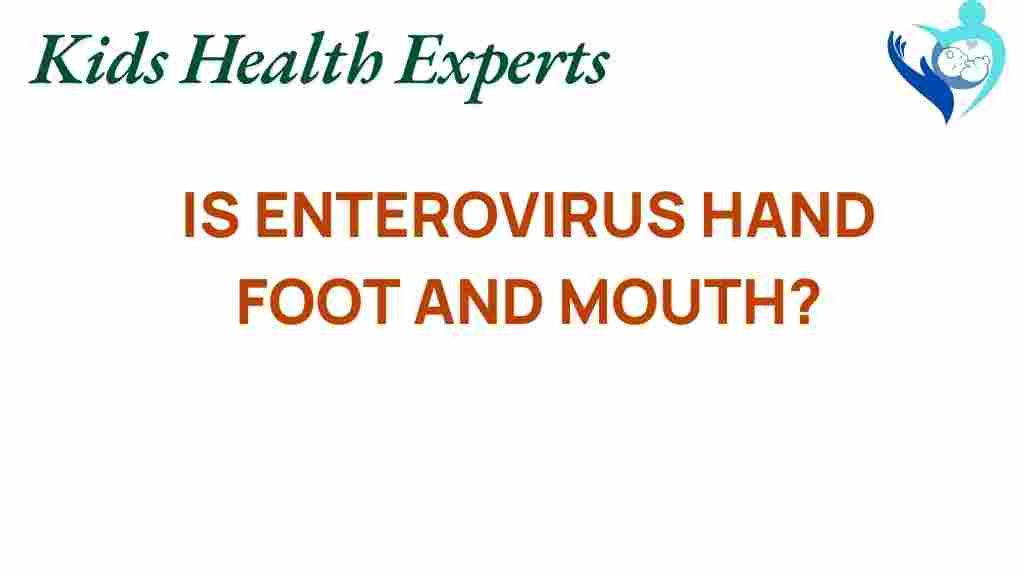Is Enterovirus Hand, Foot, and Mouth Disease? Understanding the Connection
Hand, Foot, and Mouth Disease (HFMD) is a common viral illness that primarily affects children under the age of five. It is characterized by sores in the mouth and a rash on the hands and feet. But what exactly causes this illness? Is it linked to the Enterovirus? In this article, we will unravel the truth about Enterovirus and its relation to Hand, Foot, and Mouth Disease, including symptoms, transmission, prevention, and outbreaks.
Understanding Enterovirus and Hand, Foot, and Mouth Disease
Enteroviruses are a group of viruses that can cause a range of illnesses, from mild respiratory infections to serious conditions affecting the heart and brain. One of the most notable members of this group is the Coxsackievirus, which is primarily responsible for Hand, Foot, and Mouth Disease.
What is Hand, Foot, and Mouth Disease?
Hand, Foot, and Mouth Disease is an infectious disease that results in fever, mouth sores, and a rash on the hands and feet. It is most prevalent in children but can also affect adults. The illness is typically mild, and most people recover without medical treatment.
Symptoms of Hand, Foot, and Mouth Disease
The symptoms of Hand, Foot, and Mouth Disease usually appear three to seven days after exposure to the virus. Common symptoms include:
- Fever
- Sore throat
- Painful sores in the mouth
- Rash on the hands and feet
- Loss of appetite
- Irritability in infants and toddlers
Transmission of Hand, Foot, and Mouth Disease
Hand, Foot, and Mouth Disease is highly contagious. The virus can spread through direct contact with the saliva, nasal mucus, or fluid from the blisters of an infected person. Here are some common ways the virus is transmitted:
- Close personal contact: Hugging, kissing, or sharing utensils can spread the virus.
- Respiratory droplets: Coughing or sneezing can release droplets that contain the virus.
- Contaminated surfaces: The virus can survive on surfaces and objects, making it possible to contract the disease by touching contaminated items.
Risk Factors for Children
Children are at a higher risk for Hand, Foot, and Mouth Disease due to several factors:
- Immature immune systems
- High exposure in daycare or preschool settings
- Close contact with other children who may be infected
Preventing Hand, Foot, and Mouth Disease
While it may not be possible to prevent every case of Hand, Foot, and Mouth Disease, there are several measures that can reduce the risk of transmission:
- Hand hygiene: Frequent handwashing with soap and water is essential, especially after using the restroom or changing diapers.
- Disinfect surfaces: Regularly clean and disinfect toys and surfaces that children frequently touch.
- Avoid close contact: Keep infected individuals away from others, especially vulnerable populations like infants and pregnant women.
Importance of Awareness
Raising awareness about Hand, Foot, and Mouth Disease is critical for parents and caregivers. Understanding the symptoms and transmission can help in early detection and prevention of outbreaks.
Handling Outbreaks of Hand, Foot, and Mouth Disease
Outbreaks of Hand, Foot, and Mouth Disease are common in childcare settings, schools, and summer camps. Here’s how to handle outbreaks effectively:
Step-by-Step Process for Managing Outbreaks
- Notify authorities: Inform school or daycare officials immediately if an outbreak is suspected.
- Isolate infected individuals: Keep infected children at home until they are fever-free and sores have healed.
- Increase hygiene practices: Reinforce handwashing and cleaning protocols within the facility.
- Monitor symptoms: Keep an eye on other children for signs of HFMD and report any cases promptly.
Troubleshooting Tips for Parents
If you suspect your child has Hand, Foot, and Mouth Disease, consider the following tips:
- Consult a healthcare professional: While most cases are mild, it’s essential to seek medical advice for proper diagnosis and management.
- Manage symptoms: Over-the-counter pain relievers can help alleviate fever and discomfort.
- Encourage hydration: Offer plenty of fluids to prevent dehydration, especially if your child has mouth sores.
Conclusion
In conclusion, the connection between Enterovirus and Hand, Foot, and Mouth Disease is significant, with Enteroviruses, particularly Coxsackievirus, being the primary cause of this common childhood illness. By understanding the symptoms, transmission, prevention methods, and how to handle outbreaks, parents can better protect their children and promote health awareness. Remember, while Hand, Foot, and Mouth Disease can be uncomfortable, it is generally mild and resolves on its own. Staying informed and vigilant is key to minimizing the impact of this disease.
For more information on Enteroviruses and related health issues, visit the CDC’s Enterovirus page.
For additional resources on children’s health, check out this informative guide on viral infections.
This article is in the category Conditions and created by KidsHealthExperts Team

3 thoughts on “Is Enterovirus Hand, Foot, and Mouth Disease? Unraveling the Truth”